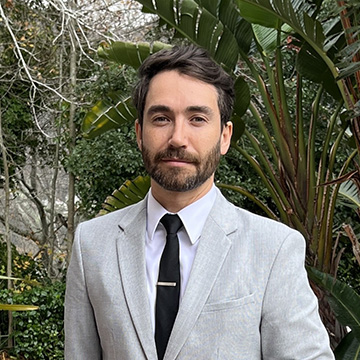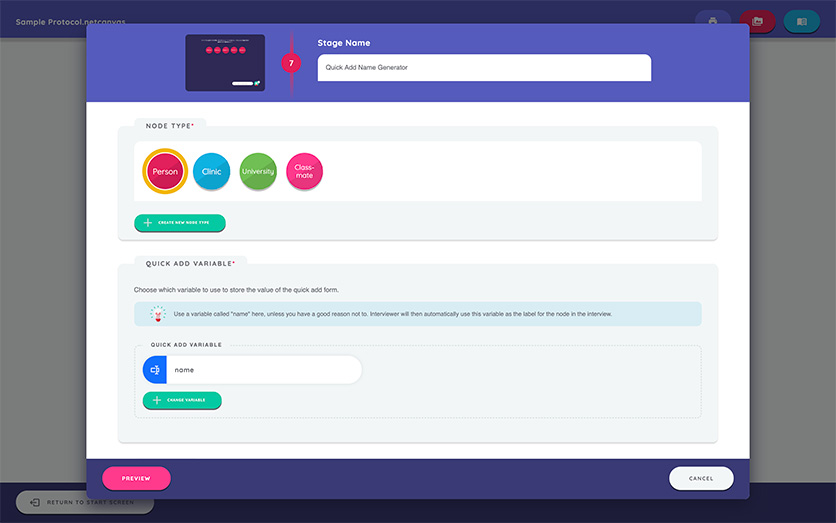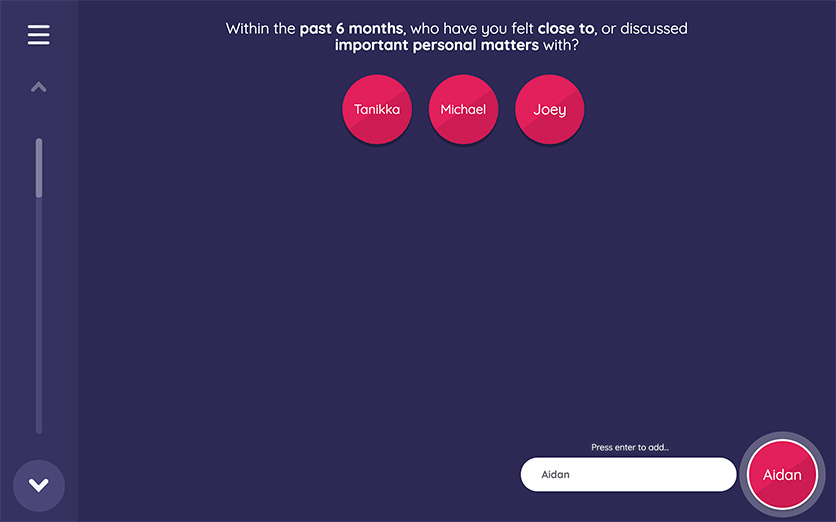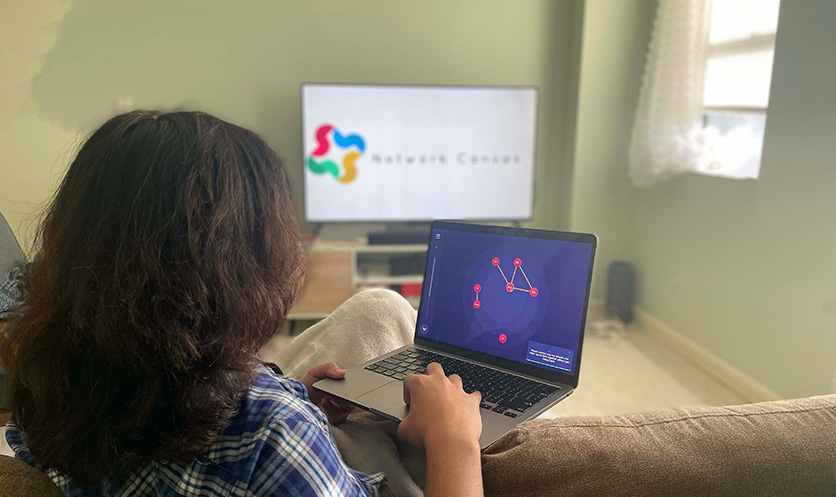Social network influence in public health and how to map it

July 29, 2025
By Andrew Nellis
Decades before the first social media influencer urged their followers to “like and subscribe,” scientists knew about the persuasive power of social networks. Our peers, as any teenager can attest, have a significant impact on our behavior, and research has shown that those relationships can affect everything from how we eat to our risk of contracting disease.
To understand those dynamics, scientists use a technique called Social Network Analysis (SNA), a process of mapping out and studying complex relationships in large communities.
However, for much of its history, performing SNA has been a lengthy, burdensome ordeal requiring researchers to painstakingly draw out physical charts with pencil and paper. But in recent years, a team of scientists at Northwestern University’s Feinberg School of Medicine have developed a better approach: a program called Network Canvas.
“We wanted to create a blank slate where people — research participants — could create representations of their social networks easily and intuitively,” said Joshua Melville, MSc, creator and lead developer of Network Canvas, and senior research associate in the Department of Medical Social Sciences. “Providing that platform allows us to understand otherwise intangible factors influencing people’s health.”

We wanted to create a blank slate where people could create representations of their social networks easily and intuitively. ”
Recent recipient of the William D. Richards, Jr. Software Award, a lifetime achievement award for software without which it would be impossible to study social networks, Network Canvas offers a simple, easy-to-use solution that any researcher can deploy to better understand their study population. To date, scientists have used it to understand trends and treatments for everything from bribery to cervical cancer.
Now, as Network Canvas moves into its newest phase of development, the team behind it hopes the program can help shed new light on long-hidden causes of disease in the United States and across the globe.
What is social network analysis and how does it impact public health?
At its most basic, social network analysis is a methodology for studying relationship patterns in a community. This is done by mapping those relationships into a visual web, showing individuals (nodes) and their personal connections (edges). That visual representation is key, as it allows researchers an intuitive view of people’s behavioral influences.
Since its earliest iteration the 1930’s, SNA has found its way into all manner of fields such as marketing, political science, and national security. In public health, it’s used to provide a contextual lens into the spread of contagious or chronic disease.
“Over the last 20 years, there’s been a real recognition of the importance relationships have in our lives, whether that be in infectious disease, public health, information sharing,” said Michelle Birkett, PhD, associate professor of Medical Social Sciences, team lead, and principal investigator for Network Canvas. “Now more than ever, understanding these influences is vital when thinking about the health of populations.”
Over the last 20 years, there’s been a real recognition of the importance relationships have in our lives, whether that be in infectious disease, public health, information sharing.”

Take, for example, the spread of HIV among Black men in the U.S. In the 2015, Black men had the highest rate of HIV diagnosis in the country (3). That finding baffled researchers, since Black men do not report higher rates of risk behaviors than White or Hispanic men.
To better understand the situation, a team of researchers at Northwestern used social network analysis to chart out a group of individuals living in the Chicago area. Using Network Canvas, they demonstrated how HIV is inextricably linked to the differences in social and contextual environments of Black men. For example, they found that Black men experienced significant segregation across their neighborhoods, their sexual partnerships, and their online spaces. Further, they were more likely to be connected to especially dense, racially isolated social networks which, combined with increased stigma about the disease and fewer community resources, made it much easier to spread infection.
The value of understanding these dynamics is two-fold. First, it answers a question that other data cannot: why would Black men have higher rate of HIV when there is no obvious difference in behavior? Second, it allows researchers and policy makers to develop interventions that influence social networks.
Network interventions run the gamut, but a few approaches include:
- Individual interventions, in which influential actors are trained to encourage healthy behaviors. One example is the ASSIST study, which successfully trained influential students to encourage their peers not to smoke.
- Segmentation interventions, that introduce new behaviors to a small group of people at once. This might be more fitting when promoting something like flu vaccines on a school-by-school basis.
- Induction interventions. These involve explicitly teaching groups of individuals how to perform certain behaviors, like eating healthier. Those participants then return to their social networks and disperse that information. The Jordan-Microclinic Social Network Behavioral Health Program is an example of an effective Induction intervention.
Beyond contagious disease, SNA can also be instrumental in understanding influences on broader health topics, such as caregiver networks or substance abuse. Research has shown that a person’s social network can have a significant impact on both their susceptibility to addiction and their success when going through recovery.
“We’ve found that friendships and other social connections can have an enormous impact on the initiation and persistence of drug use,” said Patrick Janulis, PhD, associate professor of Medical Social Sciences and multiple principle investigator on Network Canvas “If you can measure and study these relationships, you can identify real and impactful levers of change to reduce the harms of these substances.”

We’ve found that friendships and other social connections can have an enormous impact on the initiation and persistence of drug use.”
How to map social networks easily using Network Canvas
From its very beginning, Network Canvas has operated with the intent of making social network mapping simple, intuitive, flexible, secure, and perhaps above all, accessible. The program is free and open source, meaning that anyone can download and use the program at any time.
“The goal is to help people who might not know anything about network data collection to be able to perform network analysis,” said Gregory Phillips II, PhD, MS, associate professor of Medical Social Sciences and former multiple principal investigator/current co-investigator on Network Canvas. “It doesn’t matter what field you’re in, this program can be used to assess complex network factors that influence people’s health.”
It doesn’t matter what field you’re in, this program can be used to assess complex network factors that influence people’s health.”

The program itself is composed of two main applications: Architect and Interviewer.
Architect
Architect is tool which researchers use to design Network Canvas survey protocols. It condenses and simplifies the interview-building process, removing the need to enter to adjust any code. It allows researchers to build their study, create prompts, custom variables, interview stages, and interfaces. It also allows the researcher to preview the user-experience and make adjustments quickly.

Interviewer
The Interviewer app is how users will participate in the study. It is designed to be used on a tablet or computer with the assistance of an interviewer. The apps interfaces are highly visual, built much like popular apps on smart phones, allowing participants to drag, drop, or tap information.
Together, these apps provide a turn-key solution for SNA that has been used across the globe to better understand topics such as people living with dementia, climate change mitigation, and linguistic trends. That flexibility is possible thanks to the program’s open-sourced license, but according to the team, that flexibility may now be at risk.

“A core pillar of Network Canvas is that it be made available to all researchers, that it advances science everywhere,” said Melville. “That’s only been possible because of the unique funding mechanisms that supported its creation.”
Increasing access for the future
The team is currently working on the development of Network Canvas Studio, a web-based platform for designing and conducting interviews. The first milestone of this new expansion, Fresco, has already been released. It allows Network Canvas interviews to be deployed remotely, meaning researchers can simply share a study URL with their participants, thereby allowing them to complete the interview on their own device.

However, long-term access continues to be a concern. Network Canvas was developed through the support of multiple NIH grants, and recent funding uncertainty in the United States has made the future of the program unclear. While the core program exists, Studio is in active development and the maintenance of existing tools requires a significant amount of time and energy for updates.
“Network Canvas has been able to flourish because of the public investments we have received over the past ten years which have supported our highly talented, collaborative, and interdisciplinary team,” said Birkett. “We will continue to do this work as long as we can, and we hope that others will join us in new collaborations.”
Network Canvas is also supported by a broader team at Northwestern University including, Co-Investigator Noshir Contractor, PhD, Jane S. & William J. White Professor of Behavioral Sciences in the McCormick School of Engineering & Applied Science, the School of Communication and the Kellogg School of Management; Kate Banner, MA, lead project manager; Caden Buckhalt, BA, intermediate software engineer; and Co-Investigator Bernie Hogan, PhD, associate professor of Sociology at the University of Oxford.
To learn more about Network Canvas by visiting its website.